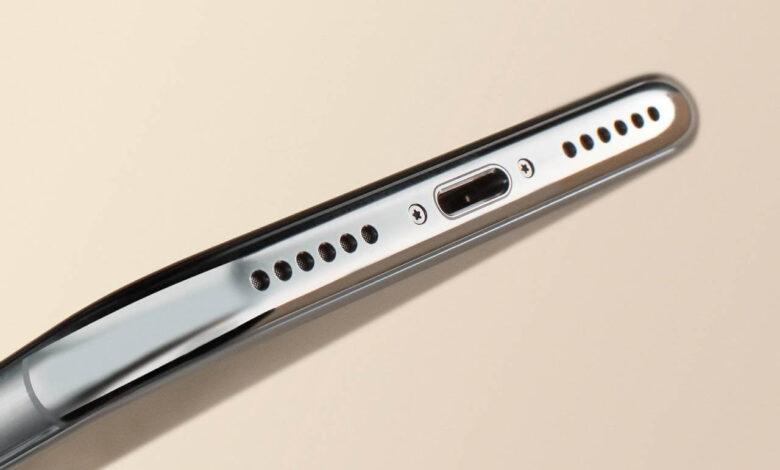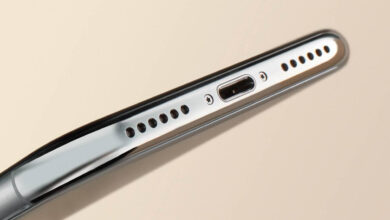Why Does Only One Side of My Phone Speaker Work? Troubleshooting Audio Issues

You might have noticed that your phone’s audio sounds a bit lopsided, with sound coming prominently from one side rather than evenly from both. This isn’t an uncommon issue and there’s usually a straightforward explanation for it. Many smartphones, including models from Apple, position their speakers in a way that might appear symmetrical, but in fact, they serve different purposes. On iPhones, for example, what you might perceive as two speakers flanking the charging port aren’t both speakers; one is a speaker and the other is a microphone. The true stereo sound involves another speaker located at the top of the phone.
If you’ve experienced a dip only on your phone speaker’s output, it might be a case of simple blockage or, in some instances, a software hiccup. Your phone’s speakers are delicate, and the openings can easily become obstructed by lint, dust, or other debris. Despite being small, these blockages can drastically affect sound quality and give the impression that one side isn’t working. Regular cleaning of your phone’s speakers might be required to maintain a crisp and balanced audio experience.
Occasionally, the issue might stem from software settings. Ensure your sound balance setting is centered, and check if the reduced sound is persistent across different apps and media. A mono audio setting might also be the culprit, as it’s designed to push sound through one channel, which is useful for those with hearing impairments in one ear but might be accidentally activated and thus confusing for users expecting stereo sound.
Understanding Phone Speaker Design
In exploring why one side of your phone speaker may not work, it’s essential to understand the typical layout and functionality of phone speakers.
Mono Vs. Stereo Speakers
You might notice that not all smartphone speakers produce sound equally. This is because phones can have either mono or stereo sound configurations.
- Mono (Monaural) speakers use a single audio channel, meaning sound comes from one source.
- Stereo speakers have two distinct audio channels, left and right, for a more immersive sound experience.
Your phone may appear to have two speakers at the bottom, but often, one is a speaker, and the other is a microphone. This misunderstanding can lead you to think one ‘speaker’ isn’t working when in reality, it was never a speaker to begin with.
Speaker Components
The components within your phone’s speaker system are compact yet sophisticated. Each speaker consists of several parts, including:
- A diaphragm which vibrates to create sound waves.
- An electromagnet that interacts with a permanent magnet to move the diaphragm.
- A voice coil attached to the diaphragm that goes in and out of the electromagnet.
Phones with stereo sound typically use the earpiece, near the top of the phone, as one audio channel in conjunction with the bottom-firing speaker to create the stereo effect. When you experience issues, it could be due to a fault in any one of these components.
Common Causes of Speaker Malfunction
When you encounter issues with your phone’s speakers, several factors could be the culprits. Let’s explore some common reasons why one side of your phone speaker might not be working.
Software Glitches
Software issues can often lead to speaker malfunctions. If your phone’s operating system or a specific application has a bug, it might cause the speaker to act erratically or produce no sound at all. You can typically resolve these issues by restarting your phone or checking for software updates.
Dirt and Debris
The tiny openings of your phone’s speaker grills attract dust, lint, and debris. Over time, these can clog the speaker and muffle the sound, or even block it entirely. Cleaning your speaker grill gently with a soft brush can often restore sound quality.
Physical Damage
Dropping your phone or exposing it to significant impact can damage internal components, including the speakers. If only one speaker is working, a loose wire or broken part inside could be the issue. In such cases, professional repair is often necessary.
Water Damage
Water and electronics don’t mix well. If your phone has been exposed to moisture and you’re now experiencing speaker issues, water damage could be to blame. Even if your phone is water-resistant, prolonged exposure or submersion can compromise speaker functionality.
Troubleshooting Steps
When you encounter issues with your phone’s speaker, following a structured approach can help pinpoint and possibly resolve the issue. Let’s go through some targeted steps to troubleshoot your phone’s one-sided speaker problem.
Basic Troubleshooting
First, restart your phone to see if it resolves the speaker issue. Sometimes, a simple reboot can fix minor software glitches. Next, check your device’s volume levels and audio settings to ensure the balance is not set to play sound from just one speaker.
- Restart Your Phone: Hold down the power button, select ‘restart’, and allow your phone to reboot.
- Check Audio Settings: Go to your phone’s settings, tap on ‘Sounds’ or ‘Audio’, and ensure the balance is centered.
Software Solutions
Investigate possible software issues that might be causing your speaker to malfunction. Make sure your phone’s software is up to date, and if Bluetooth is enabled, turn it off to see if it affects the speaker performance.
- Update Your Phone: Go to ‘Settings’ > ‘General’ > ‘Software Update’ and download any available updates.
- Disable Bluetooth: Navigate to ‘Settings’ > ‘Bluetooth’ and toggle it off to ensure no connected devices are hijacking audio output.
Cleaning Techniques
Dirt and debris can clog your speaker grilles, affecting sound quality. Use a soft brush to gently clean the speaker grille on the side that isn’t working.
- Soft Brush: Gently brush across the speaker grille to remove any visible dirt.
- Compressed Air: A short, controlled burst of air can dislodge hidden debris. Hold the can upright to avoid moisture entering the device.
Professional Repair and Replacement
When you’re faced with a phone speaker that only plays audio on one side, it might be time to consider professional help. Knowing when to seek assistance, understanding your warranty coverage, and being aware of possible costs can ensure a smooth repair experience.
When to Seek Professional Help
If you’ve tried basic troubleshooting—like checking for software updates, adjusting audio settings, and ensuring there’s no physical blockage with no success—it’s time to consult an expert. Professional repair services are equipped to diagnose and fix hardware issues that aren’t solvable at home.
Warranty and Support
Before seeking repairs, check if your phone is still under manufacturer’s warranty or if you have any additional coverage through your retailer or a third-party insurance plan. This can significantly reduce or even eliminate repair costs.
- Under Warranty: Repairs may be free or discounted.
- Out of Warranty: Expect to bear the full cost of repair.
Cost of Repair
The cost of a speaker repair can vary widely based on factors such as:
- Phone Model: Newer or premium models may be more expensive to fix.
- Extent of Damage: Simple fixes are cheaper than complex ones.
- Service Provider: Prices can differ from one repair shop to another.
| Repair Type | Estimated Cost Range |
|---|---|
| Basic Speaker Repair | $60 – $90 |
| Complex Repair | $90 – $200 |
| Official Brand Service | Varies by warranty status |
Prices are estimates and can vary by location and the specific issue at hand.
Preventative Measures
Taking care of your phone’s speakers involves not just addressing issues as they arise, but also taking steps to prevent them in the first place. Here are some specific measures you can employ to help ensure that both speakers continue to work properly.
Protective Accessories
-
Cases: Invest in a quality case that doesn’t obstruct your phone’s speakers. Cases should have precise cutouts for the speakers to avoid muffling the sound or trapping debris inside.
-
Screen Protectors: A screen protector should cover the screen but not overlap the speaker. Some speaker-related issues can arise if a screen protector is applied improperly and covers the speaker slit.
Care Tips
-
Regular Cleaning: Use a soft, dry brush to gently clean any visible dirt from the speaker grilles. Avoid pushing debris into the speaker which could cause damage.
-
Avoid Liquids: Keep your phone away from water and other liquids. Even phones advertised as water-resistant can be affected by liquid entering through the speaker grilles.
-
Handle with Care: Be mindful of how you hold your phone. Covering the speakers or dropping your phone can result in temporary or permanent damage to the speaker function.
Understanding Audio Settings
When you encounter audio issues on your phone where only one speaker seems to work, adjusting your audio settings can often provide a solution.
Equalizer Adjustments
Your phone’s equalizer can significantly affect its sound output. Most smartphones come with a built-in equalizer that you can access through the music app or settings. Here, you can adjust frequencies to enhance your music experience. If your equalizer settings are skewed to one side, it might lead to audio playing only from one speaker.
- To adjust the equalizer:
- Go to your music player app or settings.
- Locate the equalizer option.
- Ensure all frequencies are balanced and not turned toward one side.
Balance Settings
Balance settings control the distribution of sound between the left and right speakers. An incorrect balance setting might be the reason why sound is only coming from one side of your phone.
- To check balance settings:
- Open Settings.
- Go to Accessibility > Audio/Visual.
- Find the Balance slider.
- Make sure the slider is centered to equally distribute sound between both speakers.
Future of Phone Speakers
In exploring the future of phone speakers, you’ll discover advancements that aim to enhance your audio experience and innovations that may revolutionize how you listen to media on your devices.
Technological Advances
Recent trends in smartphone development suggest that future phone speakers will likely focus on improved sound quality and immersive audio experiences. You can expect further integration of spatial audio technologies, where the sound moves with you, creating a more dynamic listening experience. Additionally, advancements in materials science could lead to the inclusion of more resilient and higher-fidelity speakers that are less susceptible to common issues like one-sided speaker failure.
Innovations in Smartphone Audio
The innovations in smartphone audio are not just about loudness or clarity, but also about smart features. Adaptive audio systems may become mainstream, intelligently adjusting sound profiles based on your environment. Future smartphones might also incorporate multiple speakers that offer a true stereo effect, surpassing the conventional two-speaker setup. Moreover, companies are likely to invest in software enhancements, such as personalized sound settings and AI-driven noise cancellation, offering you a tailored audio experience that is both rich and crisply defined.
